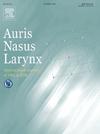Clinical characteristics and diagnostic value of symptoms and objective findings in patulous eustachian tube: a large-scale study based on the Japan Otological Society criteria
IF 1.5
4区 医学
Q2 OTORHINOLARYNGOLOGY
引用次数: 0
Abstract
Objective
To clarify the clinical characteristics of patulous Eustachian tube (PET) based on the Japan Otological Society (JOS) diagnostic criteria and to assess the diagnostic contribution of individual symptoms and objective findings.
Methods
We retrospectively analyzed patients diagnosed with definite PET or non-PET at a subspecialty Eustachian tube clinic between June 2019 and July 2025, excluding possible PET to minimize diagnostic uncertainty. Demographics, background factors, symptoms, and objective test results—including tympanic membrane (TM) flutter, tubo-tympano-aerodynamic graphy, and sonotubometry—were examined. Logistic regression identified independent factors, and receiver operating characteristic (ROC) curves were generated to evaluate diagnostic performance.
Results
Among 1009 patients (1613 ears), definite PET was associated with habitual sniffing (OR = 8.18), history of weight loss (OR = 1.78), and, in females, low-dose estrogen–progestin use (OR = 7.31). Lower body mass index and younger age also showed significant associations. Voice autophony (OR = 4.09) and breathing autophony (OR = 9.98) were the most predictive symptoms. Objective findings demonstrated high diagnostic accuracy, with TM flutter showing the highest odds ratio (OR = 42.17). The seven-symptom model achieved an area under the ROC curve (AUC) of 0.862.
Conclusion
This large-scale study identified key background factors and symptoms valuable for PET diagnosis and confirmed that objective tests have strong discriminatory ability, supporting earlier and more accurate clinical decision-making.
基于日本耳科学会标准的咽鼓管扩张性临床特征及客观表现的诊断价值
目的根据日本耳科学会(JOS)的诊断标准,明确扩张性咽鼓管(PET)的临床特点,评价个体症状和客观表现的诊断贡献。方法回顾性分析2019年6月至2025年7月在一家亚专科耳咽管诊所确诊为PET或非PET的患者,排除可能的PET以减少诊断的不确定性。研究了人口统计学、背景因素、症状和客观测试结果,包括鼓膜(TM)颤振、管-鼓膜-气动图和超声管测量。Logistic回归确定独立因素,并生成受试者工作特征(ROC)曲线来评估诊断效果。结果1009例患者(1613耳)中,PET与习惯性嗅探(OR = 8.18)、体重减轻史(OR = 1.78)以及女性低剂量雌激素-黄体酮使用(OR = 7.31)相关。较低的身体质量指数和较年轻的年龄也显示出显著的关联。语音自音(OR = 4.09)和呼吸自音(OR = 9.98)是最具预测性的症状。客观结果显示诊断准确性高,TM颤振的优势比最高(OR = 42.17)。七症状模型的ROC曲线下面积(AUC)为0.862。结论本大规模研究确定了PET诊断有价值的关键背景因素和症状,证实了客观检查具有较强的区分能力,支持临床更早、更准确的决策。
本文章由计算机程序翻译,如有差异,请以英文原文为准。
求助全文
约1分钟内获得全文
求助全文
来源期刊

Auris Nasus Larynx
医学-耳鼻喉科学
CiteScore
3.40
自引率
5.90%
发文量
169
审稿时长
30 days
期刊介绍:
The international journal Auris Nasus Larynx provides the opportunity for rapid, carefully reviewed publications concerning the fundamental and clinical aspects of otorhinolaryngology and related fields. This includes otology, neurotology, bronchoesophagology, laryngology, rhinology, allergology, head and neck medicine and oncologic surgery, maxillofacial and plastic surgery, audiology, speech science.
Original papers, short communications and original case reports can be submitted. Reviews on recent developments are invited regularly and Letters to the Editor commenting on papers or any aspect of Auris Nasus Larynx are welcomed.
Founded in 1973 and previously published by the Society for Promotion of International Otorhinolaryngology, the journal is now the official English-language journal of the Oto-Rhino-Laryngological Society of Japan, Inc. The aim of its new international Editorial Board is to make Auris Nasus Larynx an international forum for high quality research and clinical sciences.
 求助内容:
求助内容: 应助结果提醒方式:
应助结果提醒方式:


